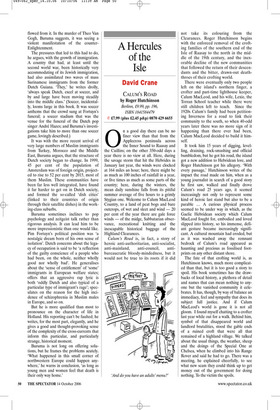A Hercules of the Isle
David Crane
CALUM’S ROAD by Roger Hutchinson Berlinn, £9.99, pp. 196, ISBN 1841584479 ✆ £7.99 (plus £2.45 p&p) 0870 429 6655 On a good day there can be no finer view than that from the Applecross peninsula across the Inner Sound to Raasay and the Cuillins; on the other 350-odd days a year there is no view at all. Here, during the savage storm that hit the Hebrides in January last year, the winds were clocked at 164 miles an hour; here, there might be as much as 100 inches of rainfall in a year, or five times as much as some parts of the country; here, during the winters, the mean daily sunshine falls from its pitiful summer average of five hours to a grimly Stygian one. Welcome to Calum MacLeod Country, to a land of peat bogs and bare outcrops, of wet and sleet and wind — 20 per cent of the year there are gale force winds — of the midge, Sabbatarian observance, recreational knitting and the inescapable historical baggage of the Highland Clearances.
Calum’s Road is, in fact, a story of heroic anti-authoritarian, anti-socialist, anti-mainland, anti-council, antibureaucratic bloody-mindedness, but it would not be true to its roots if it did not take its colouring from the Clearances. Roger Hutchinson begins with the enforced removal of the crofting families of the southern end of the Isle of Raasay to the north in the middle of the 19th century, and the inexorable decline of the new communities that followed the return of their descendants and the bitter, drawn-out deaththroes of their crofting world.
There were eventually only two people left on the island’s northern finger, a crofter and part-time lighthouse keeper, Calum MacLeod, and his wife, Lexie, the Torran School teacher while there were still children left to teach. Since the 1920s Calum’s family had been petitioning Inverness for a road to link their community to the south, so when 40-odd years later there was no more sign of it happening than there ever had been, Calum MacLeod decided to build it himself.
It took him 15 years of digging, levelling, draining, rock-smashing and official bumbledom, but he got his road, the island got a new addition to Hebridean lore, and Roger Hutchinson got his allegory. ‘With every passage,’ Hutchinson writes of the impact the road made on him, when as a young journalist in search of a good story he first saw, walked and finally drove Calum’s road 25 years ago, it seemed increasingly not only to represent some kind of heroic last stand but also to be a parable ... A curious physical process seemed to be under way in which, as the Gaelic Hebridean society which Calum MacLeod fought for, embodied and loved slipped into history, so his immense, defiant gesture became increasingly significant. A cultural mountain had eroded, but as it was washed away the remnant bedrock of Calum’s road appeared as haunting and precious as fossilised footprints on any other distant shore.
The fate of that crofting world is, as Hutchinson knows, much more complicated than that, but it is too good a story to spoil. His book sometimes has the drawbacks of local history, a plethora of detail and names that can mean nothing to anyone but the vanished community it celebrates. It has, though, by way of balance an immediacy, feel and sympathy that does its subject full justice. And if Calum MacLeod’s world is gone it is not all gloom. I found myself chatting to a crofter last year while out for a walk. Behind him, symbol of that disappeared world and landlord brutalities, stood the gable ends of a ruined croft that were all that remained of a highland village. We talked about the usual things, the weather, sheep and the doings of the Special One at Chelsea, when he climbed into his Range Rover and said he had to go. There was a meeting, he explained cheerfully, to see what new scam they could think up to get money out of the government for doing nothing. To the victim the spoils.


































































































 Previous page
Previous page